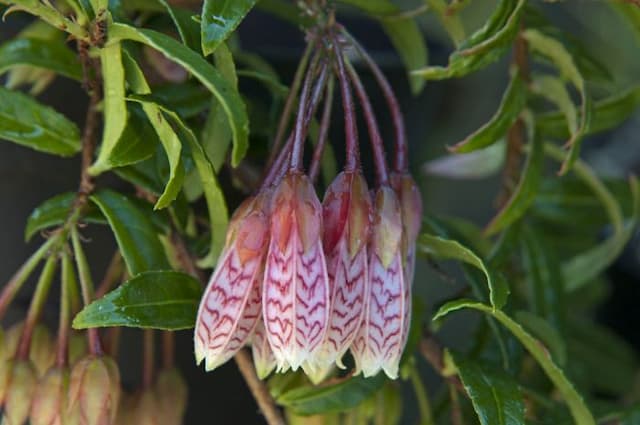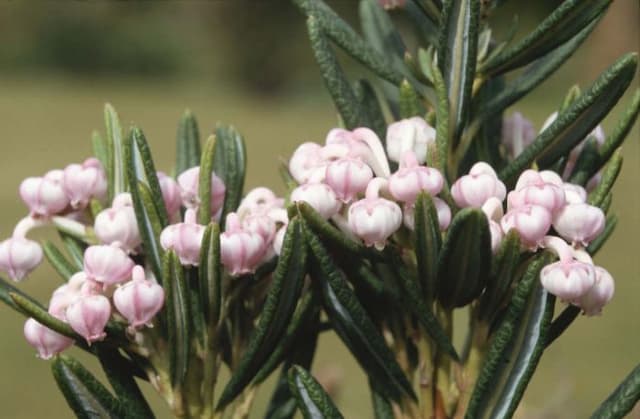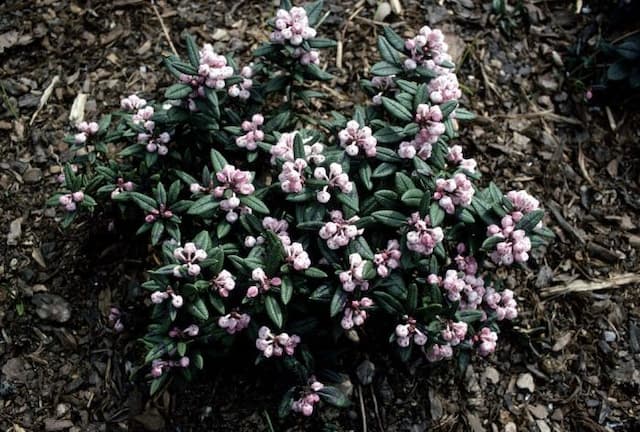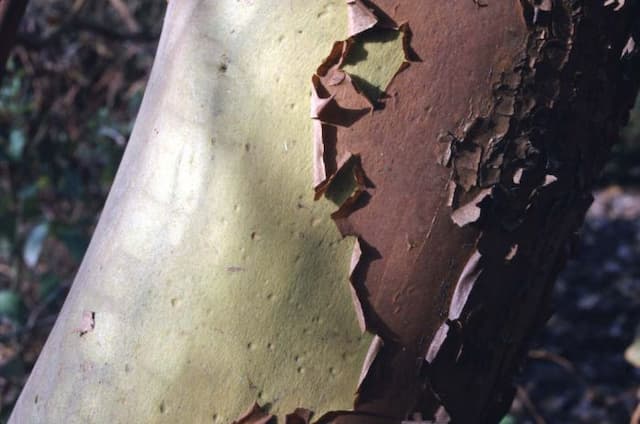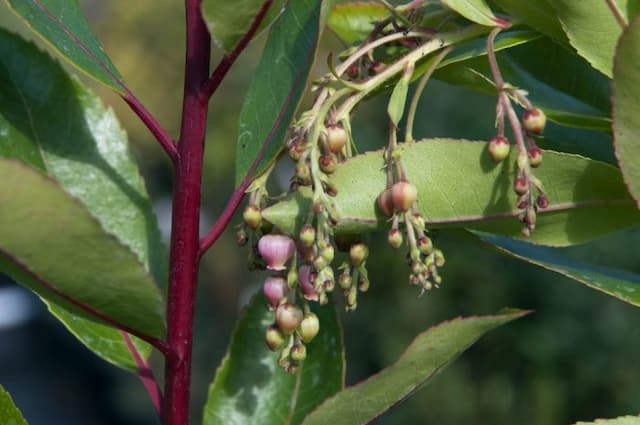King Rhododendron Rhododendron rex

ABOUT
The Rhododendron rex, commonly known as the King Rhododendron, is an impressive evergreen shrub that is admired for its large and glossy, dark green leaves. Each leaf can be quite broad and elongated, with a thick leathery texture, and often displaying a fuzzy underside. The edges of the leaves may be slightly curved, giving them a unique and elegant contour. During its blooming season, the King Rhododendron is adorned with remarkable flowers. These blossoms form large, dome-shaped clusters at the ends of the branches. Each individual flower is bell-shaped and may come in a variety of shades ranging from pale pink to a deep, striking purple, often with beautiful speckling inside the throat of the bloom. The plant has a robust and woody structure with branches spreading to form a dense, rounded shrub. Its bark is typically rough and has a rugged texture, which provides a strong contrast to the delicate flowers and lush foliage. Contributing to its royal appearance, the King Rhododendron's overall aspect is one of grandeur and sturdiness, making it a beloved focal point in gardens where its beauty and splendor can truly be appreciated. Its evergreen nature ensures that it provides year-round interest, retaining its luxurious leaves throughout the seasons.
About this plant
 Names
NamesFamily
Ericaceae
Synonyms
King Rhododendron, Rex Rhododendron
Common names
Rhododendron fictolacteum, Rhododendron neriiflorum var. omeiense.
 Toxicity
ToxicityTo humans
The Rhododendron, which includes the Rhododendron rex, is known to contain toxic compounds, particularly grayanotoxins. All parts of the plant are considered poisonous if ingested. The severity of poisoning can vary depending on the amount consumed. Symptoms in humans can include nausea, vomiting, diarrhea, hypotension (low blood pressure), and bradycardia (slow heart rate). In severe cases, ingestion may lead to a drop in blood pressure, stupor, convulsions, or even coma. Medical attention should be sought immediately if poisoning is suspected.
To pets
Rhododendrons, including the Rhododendron rex, are toxic to pets such as dogs and cats. They contain grayanotoxins that can cause serious health issues in animals if ingested. Symptoms of poisoning in pets can include drooling, vomiting, diarrhea, loss of appetite, abdominal pain, weakness, and potentially, cardiac problems. In severe cases, seizures, coma, and death may occur. It is imperative to keep pets away from Rhododendrons, and if ingestion occurs, contact a veterinarian immediately.
 Characteristics
CharacteristicsLife cycle
Perennials
Foliage type
Evergreen
Color of leaves
Green
Flower color
Varies
Height
5 feet (1.52 meters)
Spread
5 feet (1.52 meters)
Plant type
Shrub
Hardiness zones
7
Native area
China
Benefits
 General Benefits
General Benefits- Ornamental Value: Rhododendron rex, commonly known as the King Rhododendron, is highly prized for its large, attractive leaves and stunning flowers that enhance the aesthetic appeal of gardens and landscapes.
- Habitat Support: It provides shelter and food for various species of birds, insects, and wildlife, supporting biodiversity.
- Erosion Control: The robust root system of King Rhododendron helps in stabilizing soil and preventing erosion, particularly on slopes.
- Shade Provider: With its large foliage, the plant can create shaded areas in the garden, offering a cool retreat during sunny days.
- Privacy Screen: When planted in groups, Rhododendron rex can act as an effective natural privacy screen.
- Year-Round Interest: This species offers evergreen foliage, providing greenery and visual interest even in the winter months.
- Cultural Significance: In some regions, it is celebrated for its beauty and has cultural importance during festivals.
 Medical Properties
Medical PropertiesThis plant is not used for medical purposes
 Air-purifying Qualities
Air-purifying QualitiesThis plant is not specifically known for air purifying qualities.
 Other Uses
Other Uses- Rhododendron rex is sometimes used in the creation of bonsai plants due to its impressive foliage and the potential for artistic pruning.
- The plant's large leaves can be used as a natural wrapping material for small packages or to wrap food items in a survival situation.
- With its striking flowers, Rhododendron rex is often used for ceremonial decorations and in festive floral arrangements.
- The wood of Rhododendron rex is occasionally utilized in the crafting of small wooden items, such as handles for garden tools.
- Dried parts of Rhododendron rex may be used in potpourri for their textural contrast, although they are not typically known for their fragrance.
- In landscape design, the plant is used to create privacy screens or hedges due to its dense growth habit.
- Rhododendron rex leaves can serve as a natural dye source for fabrics, yielding various shades of brown and yellow.
- The bark of Rhododendron rex can be used in small quantities to add texture and visual interest to mulches in garden beds.
- Photographers and painters often use the attractive blooms and leaves of Rhododendron rex as subjects for artistic work.
- Educational institutions may utilize Rhododendron rex in botany courses to teach about plant structure and reproductive systems due to its clear flower morphology.
Interesting Facts
 Feng Shui
Feng ShuiRhododendron is not used in Feng Shui practice.
 Zodiac Sign Compitability
Zodiac Sign CompitabilityRhododendron is not used in astrology practice.
 Plant Symbolism
Plant Symbolism- Beware: Rhododendrons, including Rex varieties, are known to be toxic. Their symbolism often includes a caution or warning, reflecting the dangers they possess if ingested.
- Elegance: The large, showy flowers of the Rhododendron rex symbolize elegance and sophistication, mirroring the plant's royal namesake and stately appearance.
- Abundance: With its lush, abundant blooms, the Rhododendron rex is often associated with abundance and wealth, signifying growth and prosperity.
- Temperance: The evergreen nature and hardiness of the Rhododendron rex suggest temperance and moderation, as the plant thrives in balanced environments.
- Homecoming: In certain cultures, rhododendrons are given to welcome people home, symbolizing an invitation to return and the pleasure of reunion.
 Water
WaterKing Rhododendron should be watered thoroughly, ensuring that the soil is moist but not waterlogged. Typically, during the growing season, it requires water every 7 to 10 days, depending on the climate and weather conditions. In average conditions, you should provide about 1 gallon of water per week for each plant, adjusting as necessary during hot or dry periods. Overhead watering is discouraged as it can promote fungal diseases; instead, water at the base of the plant to keep the leaves dry. During the winter and in cooler climates, reduce watering to prevent root rot, but the soil should never be allowed to dry out completely.
 Light
LightKing Rhododendron thrives in dappled shade or partial sunlight. The best spot for this plant is one that offers protection from the harsh afternoon sun, which can scorch the leaves. Morning light with afternoon shade or light that filters through a canopy of trees is ideal for the King Rhododendron to flourish.
 Temperature
TemperatureKing Rhododendron prefers a climate with moderate temperatures and can tolerate a range from 20°F to 80°F. The ideal temperature for this plant is between 50°F and 70°F. Avoid placing it in locations where temperature extremes are common, as it may not survive prolonged exposure to temperatures below 20°F or above 80°F.
 Pruning
PruningKing Rhododendron benefits from pruning to maintain its shape, encourage bushier growth, and remove any dead or diseased branches. The best time for pruning is shortly after the plant has finished blooming in spring, as this avoids cutting off next year's buds. Prune sparingly, removing only what is necessary, and always make clean cuts just above a set of leaves.
 Cleaning
CleaningAs needed
 Soil
SoilThe King Rhododendron prefers acidic soil with a pH of 4.5 to 6. The best soil mix is a blend of 50% peat moss or pine bark to ensure acidity and aeration, 30% perlite or vermiculite for drainage, and 20% organic matter like leaf mold or compost for nutrients.
 Repotting
RepottingKing Rhododendrons should be repotted every 2 to 3 years, ideally in spring before they begin their active growth cycle. They thrive when not overly disturbed, so repotting too frequently should be avoided.
 Humidity & Misting
Humidity & MistingKing Rhododendrons prefer high humidity levels, ideally between 60% to 80%. They thrive in moist, humid environments, which can be maintained by using a humidifier or placing a tray of water near the plant.
 Suitable locations
Suitable locationsIndoor
Use acidic soil, place in bright, indirect light, and maintain high humidity.
Outdoor
Plant in part shade, use acidic soil, and protect from harsh winds.
Hardiness zone
7-9 USDA
 Life cycle
Life cycleRhododendron rex, commonly known as King Rhododendron, begins its life cycle with seed germination, which requires a cold period to break dormancy followed by higher temperatures to initiate sprouting. Seedlings establish themselves with a primary root system and grow their first leaves, utilizing stored energy until they can photosynthesize independently. As the plant matures, it develops a woody stem and a robust root system, supporting the growth of evergreen leaves and the distinctive large, leathery foliage characteristic of mature Rhododendron rex plants. The plant reaches reproductive maturity in several years, producing clusters of showy flowers, often in shades of white to pink, which attract pollinators for sexual reproduction. Following pollination, ovules develop into seeds within a woody capsule that eventually opens to release seeds, completing the life cycle. In ideal conditions, King Rhododendron can live for many decades, with some specimens known to live over a century, continuously growing, flowering, and producing seeds.
 Propogation
PropogationPropogation time
Spring-Early Summer
The most popular method for propagating Rhododendron rex, commonly known as the King Rhododendron, is through semi-hardwood cuttings. This involves taking a cutting of new growth that has started to harden, usually around mid-summer to early autumn. The cutting, typically 4 to 6 inches (about 10 to 15 centimeters) long, is snipped just below a set of leaves, and the lower leaves are removed. The cut end is then dipped into a rooting hormone powder or solution to encourage root development. After that, the cutting is placed in a well-draining potting mix and kept at a consistent humidity level. A plastic cover can help maintain the humidity, but it's important to avoid direct sunlight to prevent overheating. It can take several months for the cutting to root sufficiently for transplanting.
